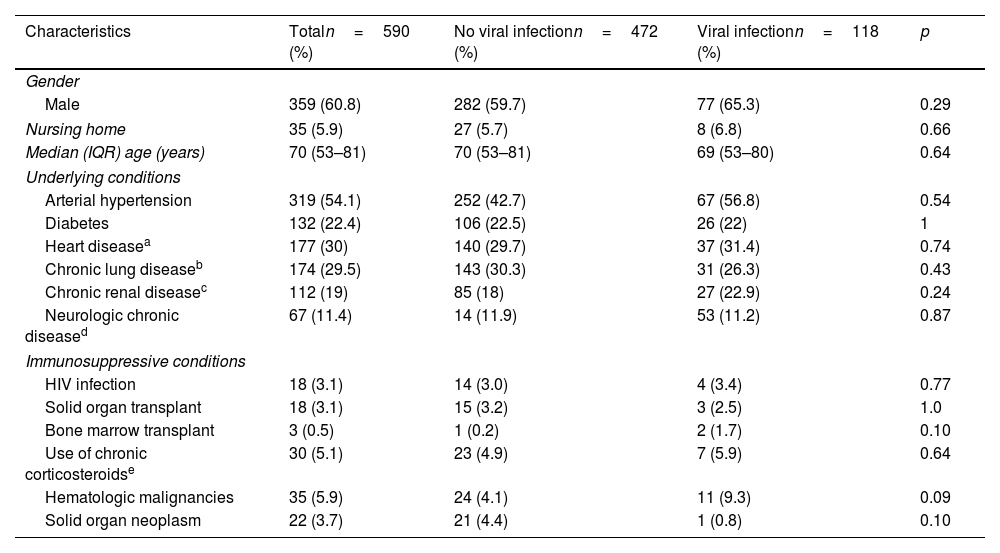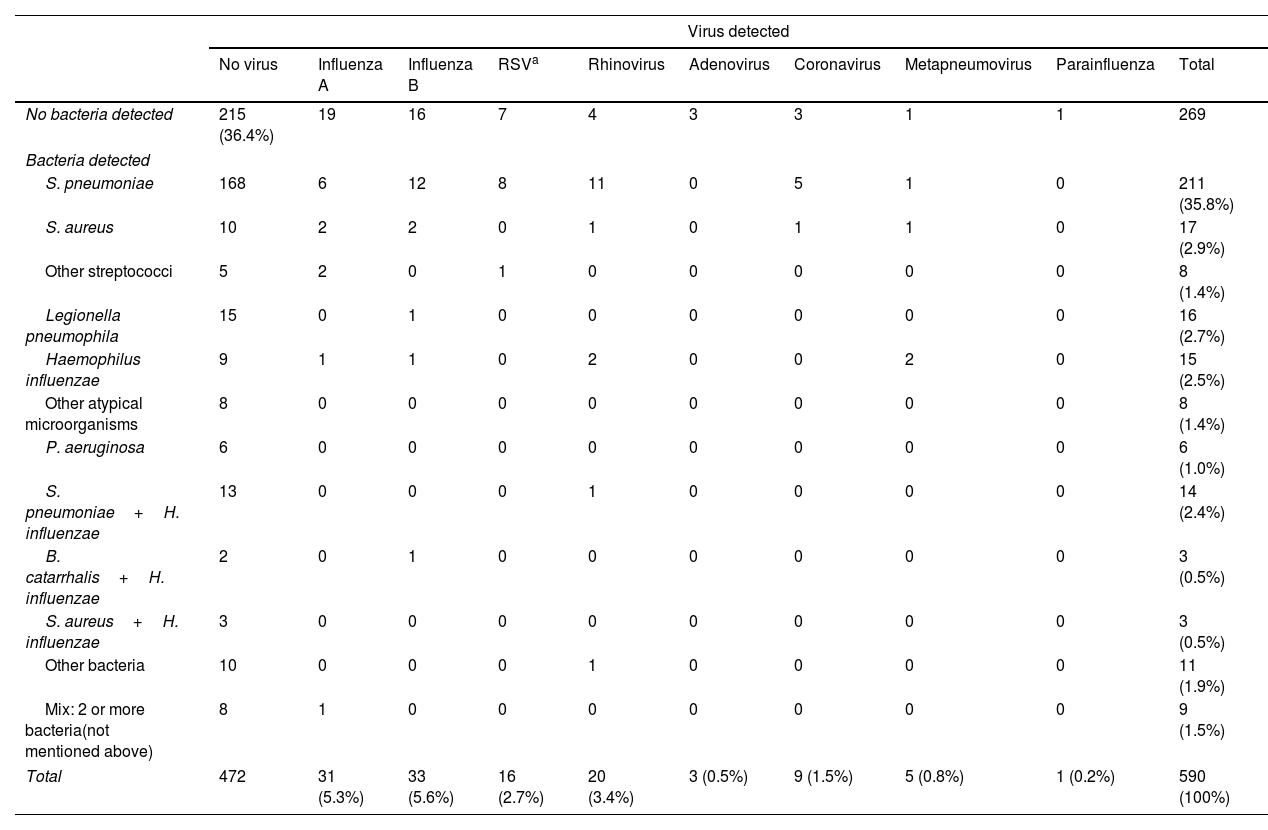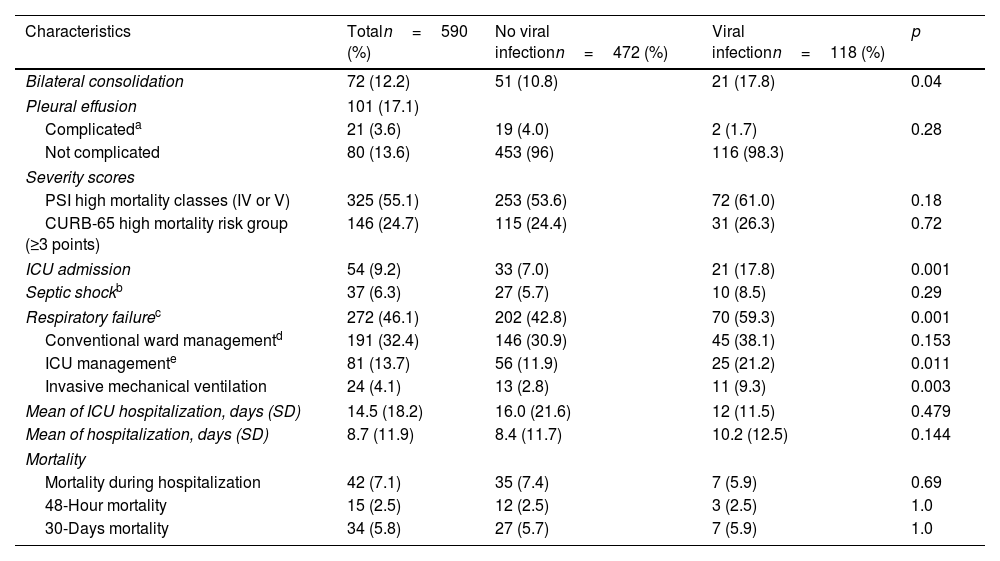The presence of a respiratory virus in patients with community-acquired pneumonia (CAP) may have an impact on the bacterial etiology and clinical presentation. In this study we aimed to assess the role of viral infection in the bacterial etiology and outcomes of patients with CAP.
MethodsWe performed a retrospective study of all adults hospitalized with CAP between November 2017 and October 2018. Patients were classified according to the presence of viral infection. An unvaried and a multivaried analysis were performed to identify variables associated with viral infection and clinical outcomes.
ResultsOverall 590 patients were included. A microorganism was documented in 375 cases (63.5%). A viral infection was demonstrated in 118 (20%). The main pathogens were Streptococcus pneumoniae (35.8%), Staphylococcus aureus (2.9%) and influenza virus (10.8%). A trend to a higher rate of S. aureus (p=0.06) in patients with viral infection was observed. Patients with viral infection had more often bilateral consolidation patterns (17.8% vs 10.8%, p=0.04), respiratory failure (59.3% vs 42.8%, p=0.001), ICU admission (17.8% vs 7%, p=0.001) and invasive mechanical ventilation (9.3% vs 2.8%, p=0.003). Risk factors for respiratory failure were chronic lung disease, age >65 years, positive blood cultures and viral infection. Influenza, virus but no other respiratory viruses, was associated with respiratory failure (OR, 3.72; 95% CI, 2.06–6.73).
ConclusionsOur study reinforces the idea that co-viral infection has an impact in the clinical presentation of CAP causing a more severe clinical picture. This impact seems to be mainly due to influenza virus infection.
La presencia de virus respiratorios en pacientes con neumonía adquirida en la comunidad (NAC) puede tener un impacto en la etiología bacteriana y en la presentación clínica. El objetivo de este estudio fue evaluar el papel de la infección viral en la etiología bacteriana y la evolución de los pacientes con NAC.
MétodosRealizamos un estudio retrospectivo de todos los adultos hospitalizados con diagnóstico de NAC entre noviembre de 2017 y octubre de 2018. Los pacientes fueron clasificados según la presencia de infección viral. Se realizó un análisis univariado y multivariado para identificar variables asociadas con la infección viral y la evolución clínica.
ResultadosEn total se incluyeron 590 pacientes. Se documentó el microorganismo en 375 casos (63,5%). Se demostró una infección viral en 118 (20%). Los principales patógenos fueron S. pneumoniae (35,8%), S. aureus (2,9%) y virus de la influenza (10,8%). Se observó una tendencia a una mayor tasa de S. aureus (p=0,06) en pacientes con infección viral. Los pacientes con infección viral tenían con mayor frecuencia patrones de consolidación bilateral (17,8% vs 10,8%; p=0,04), insuficiencia respiratoria (59,3% vs 42,8%; p=0,001), ingreso en UCI (17,8% vs 7%; p=0,001) y necesidad de ventilación mecánica invasiva (9,3% vs 2,8%; p=0,003). Los factores de riesgo para insuficiencia respiratoria fueron enfermedad pulmonar crónica, edad >65 años, hemocultivos positivos e infección viral. El virus de la influenza, pero ningún otro virus respiratorio, se asoció con insuficiencia respiratoria (OR: 3,72; IC 95%: 2,06-6,73).
ConclusionesNuestro estudio refuerza la idea de que la infección viral tiene un impacto en la presentación clínica de la NAC provocando un cuadro clínico más grave. Este impacto parece deberse principalmente a la infección por el virus de la influenza.












